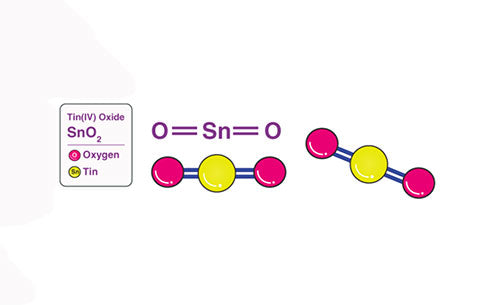
(1) Lithium storage mechanism of tin oxide. Simple tin oxides include tin oxide, stannous oxide and their mixtures. Compared with the theoretical specific capacity of carbon materials of 372mA·h/g, the specific capacity of tin oxide is much higher, reaching more than 500mA·h/g, but the first irreversible capacity is also larger.
Regarding the lithium storage mechanism of Sn oxides, there are currently two views: one is an alloy type and the other is an ionic type. According to the ionic mechanism, the deintercalation process of Li is:

The alloy-type lithium storage mechanism believes that Li and tin oxide or stannous oxide are carried out in two steps during the charge and discharge process:
The first step is to replace Sn in tin oxide or stannous oxide with Li to produce metal Sn and Li2O. This step is irreversible; then metal Sn reacts reversibly with metal Li to form a LiSn alloy.
Almost all experimental phenomena support the alloy-type lithium storage mechanism: in the ionic mechanism, the reaction can only reversibly generate a phase of lithium (stannous), and there is no Li2O generation, and the first charge and discharge efficiency is high; in the alloy type mechanism, due to the irreversible Li2O formation in the first step, the first charge and discharge efficiency is very low. XRD analysis observed separated metal Sn and Li2O, but not uniform LixSnO2 (LixSnO) phase. Electron paramagnetic resonance spectroscopy and XPS analysis also show that Li exists in the form of atoms in the Sn oxide. Through XRD, Raman and high resolution electron microscopy analysis of Sn oxide represented by SnO, it is proved that the deintercalation mechanism of Sn oxide is an alloy type mechanism.
The alloy-type deintercalation mechanism believes that the first irreversible capacity is caused by the formation of Li2O in the first step of the reaction, and the decomposition or condensation of Sn oxide with the organic electrolyte, and the reversible capacity is caused by the formation of an alloy between metal Sn and Li. Before the substitution reaction and the alloying skin should proceed, the organic electrolyte on the surface of the particles decomposes to form an amorphous passivation film. The thickness of the passivation film is several nanometers, and the composition is Li2CO3 and alkyl Li (ROCO2 Li). In the substitution reaction, fine Sn particles are generated in nanometer size and are highly dispersed in lithium oxide. In the alloying reaction, the LixSn produced also has a nanometer size. The reason for the high capacity of Sn oxide as the negative electrode material is that there are nanometer-sized Li particles in the reaction product.
(2) Preparation method and electrochemical performance. There are many methods for preparing tin oxide, including high temperature solid phase method, mechanical ball milling method, sol-gel method, template method, electrostatic thermal spraying method (ESD), radio frequency magnetron sputtering (RF), vacuum thermal evaporation (ED), chemical vapor deposition (CVD), etc. The first few methods generally produce powder materials, and the last four methods produce thin film materials. The properties of (stannous) tin oxide obtained by different methods are different. From the perspective of material form, there are powdery (solid phase method, ball milling method, Sol-gel, etc.), and thin film materials (ESD, RF, ED, CVD); from the perspective of crystal structure, there are both crystalline and amorphous; from the perspective of size, there are both nanomaterials and non-nanomaterials. About nanomaterials and thin-film electrodes will be introduced in detail in the following chapters. As the properties of (stannous) oxide prepared by different methods are different, their electrochemical properties are also very different.
The properties of tin oxide prepared by different methods are different, mainly related to the choice of voltage and the size and shape of the particles. Some people think that if the lithium insertion voltage exceeds 0.8V, Sn atoms will be generated, and when the potential exceeds 1.3V, the Li2O matrix containing the Sn atoms will be destroyed; because the Sn atoms are softer and have a lower melting point, they will gather into clusters. Once Sn clusters are formed, a two-phase region will be formed, which will cause volume mismatch during the cycle and cause capacity decay. Therefore, choosing an appropriate voltage cycle interval can inhibit the generation of tin clusters.
When the size of the electrode material is reduced to the nanometer range, the specific surface area increases, and the diffusion distance of lithium ions therein is significantly reduced. Therefore, for electrode materials of the same composition, nanomaterials have better rate characteristics. In addition, the reduction in particle size can increase lithium storage sites and shorten the lithium ion diffusion distance, thereby increasing the reversible specific capacity of tin oxide.
The main problem of tin oxide anode materials is that the first irreversible capacity is very large, and the irreversible capacity loss exceeds 50%. This is mainly due to the formation of Li2O and the formation of SEI film during the first charge and discharge mentioned above; another problem is that the change in the volume of the material during the process of deintercalating lithium (the densities of SnO2, Sn, and Li are 6.99g/cm3, 7.29g/cm3 and 2.56g/cm3, which make the volume of the material change greatly before and after the reaction) causes the electrode to "pulverize" or "agglomerate", which causes the specific capacity of the material to decrease and the cycle performance to decrease. The differential capacitance curve of SnO2 is shown in Figure 1.

Figure 1 - Differential capacitance curve of SnO2
In order to reduce the "volume effect" of tin oxide electrode materials, the following measures are usually taken: ①Prepare tin oxides with special morphologies (such as thin films, nanoparticles or amorphous) to minimize their volume expansion rate; ②Choose an appropriate battery operating voltage window to reduce the occurrence of side reactions; ③Doping the electrode, such as doping with elements such as Mo, P, and B, prevents the formation of tin clusters in the charge-discharge reaction.















